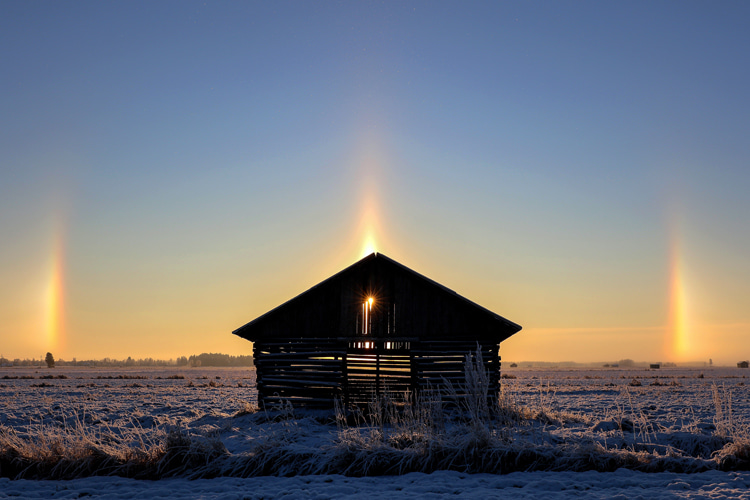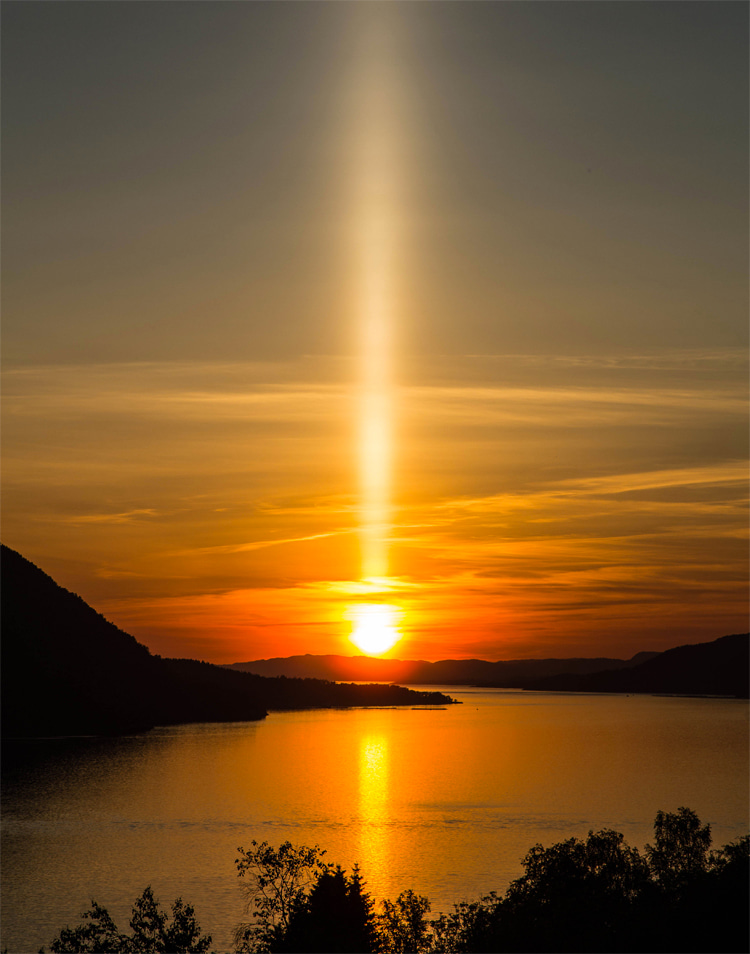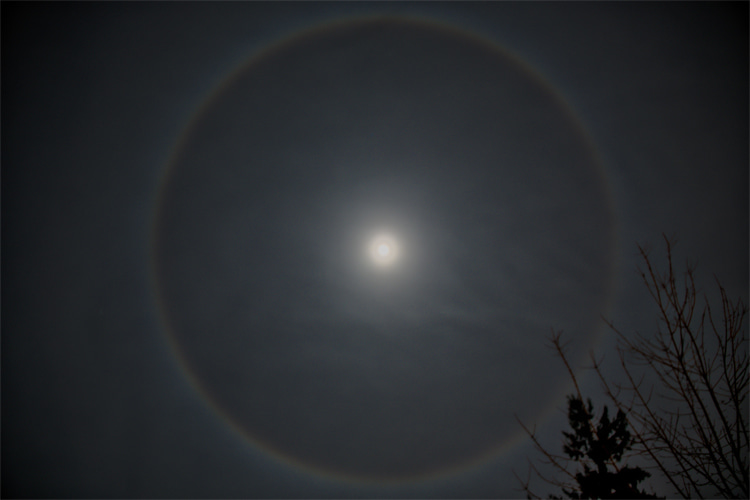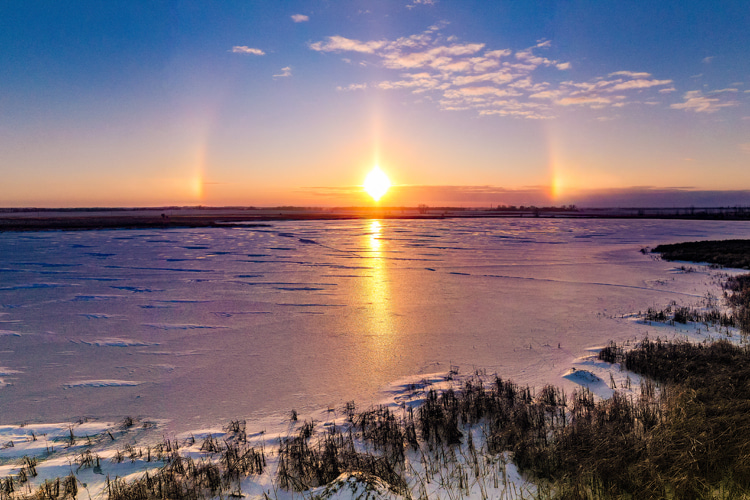A sun dog, or sundog, is a natural optical phenomenon consisting of one or two colored luminous spots appearing on either side of the Sun.
From an observer's perspective, it sometimes looks like there are one or two "false" or secondary suns.
The sundog is scientifically known as parhelion and is also commonly referred to as mock sun.
But why do sun dogs appear?
Hexagonal plate-like ice crystals suspended in the atmosphere in high and cold cirrus or cirrostratus clouds can bend the Sun's rays just like raindrops do.
So, when these tiny particles and the observer are in the same horizontal plane, the observer will notice a pair of large and bright-colored spots.
Ice crystals generate sun dogs; raindrops create rainbows.
The refraction, reflection, and dispersion of light in raindrops create a rainbow. If you want to see a rainbow, the Sun must be on your back, and rain must be falling in front of you.
The colors in a sun dog are reddish on the inside, closest to the Sun, or blueish on the outside.
The refraction of sunlight through ice crystals can produce a variety of optical visuals, sometimes turning white cirriform clouds into a display of vibrant colors.
The visual effect gets more spectacular when ice crystals are perfectly aligned at 22 degrees from the Sun, resulting in more horizontal refraction or bending of light.
These solar optics events can take place all year round, anywhere in the world, even though they are not always visible, perfect, and bright.
However, they are more frequent in the colder season when storms produce high and thin cirrus cloud decks, and the Sun is near the horizon.

Sun Dogs: History and Etymology
According to historians, the Greeks were the first to identify sun dogs.
Aristotle (382-322 BC) noted two mock suns rising with the Sun, most commonly at sunrise or sunset.
Roman statesman and philosopher Marcus Cicero (106-43 BC) referred to "this prodigy" as a "double sun."
Interestingly, no one exactly knows the origin of the term.
Etymologists believe the word "sun dog" could be associated with Norse mythology, Ancient Greece, or the Cornish dialect.

Halos vs. Sun Dogs
A sun dog is one of the many different types of halos.
It is frequently mistaken for the 22° halo, an optical phenomenon that creates a ring with a 22-degree apparent radius around the Sun or Moon.
So, how is the formation of a halo different from that of a sun dog?
Halos and sun dogs form from the refraction of light through ice crystals.
A halo is a ring of light encircling and extending outward from the Sun or Moon that appears when sunlight or moonlight is refracted as it passes through ice crystals.
The most common type of halo is the 22-degree halo; the less common is the 46-degree halo.
The 46-degree halo is an optical phenomenon that occurs when light is refracted through column-type ice crystals with diameters ranging between 15 and 25 micrometers.
The difference between halos and sun dogs is the orientation of the ice crystals through which the light passes before reaching our eyes.
Whenever the hexagonal ice crystals' flat faces are in a vertical position, observers see a halo.
Whenever their flat faces are horizontally oriented, people see a sun dog.
If a parhelion is a sun dog, what is an anthelion?
An anthelion is also caused by hexagonal ice crystals suspended in the atmosphere, but it is observed at the azimuth opposite the Sun.

Sun Pillars
Whereas sun dogs and halos are caused by sunlight refraction through ice crystals, sun pillars are caused by the reflection of sunlight off ice crystals.
Sun pillars are the result of sunlight reflecting off gently falling ice crystals.
Sun pillars tend to appear most often at sunrise or sunset as a vertical shaft of light extending upward or downward from the Sun.
Pillars may form as hexagonal ice crystals fall with their flat bases oriented horizontally.
As the small crystals fall in still air, they tilt from side to side like a falling leaf.
This motion allows sunlight to reflect off the crystals' tipped surfaces, producing a relatively bright area in the sky above or below the Sun.
Pillars may also form as sunlight reflects off hexagonal pencil-shaped ice crystals that fall with their long axes oriented horizontally.
Sun pillars can be found when the Sun is low on the horizon and cirrus clouds are present.

Moon Dogs
Whenever ice crystals fall through the atmosphere at night, they produce a sun-dog-like effect beside the Moon. These spots are called moon dogs.
Moon dogs appear as part of the 22-degree halo, roughly ten Moon diameters (around 4,317 miles or 6,948 kilometers) outside the Moon.
Although exactly analogous to sun dogs, they are rarer because the Moon must be bright - about a quarter Moon or more - for the phenomenon to be observed.
A Moon dog shows little color to the naked eye because its light is not bright enough to activate the photoreceptor cells found in the human eye.
